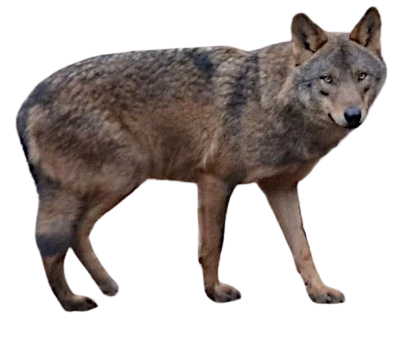
The Iberian Wolf (Canis lupus signatus) is a subspecies of the gray wolf, native to the Iberian Peninsula. It is considered one of the most endangered wolf populations, with dedicated conservation efforts aimed at preserving it.
The Iberian Wolf is slightly smaller than the common gray wolf, typically measuring between 60 and 80 cm at the shoulder, and weighing between 25 and 45 kg. Its fur, which is usually gray or reddish-brown, is lighter on the underside and features distinctive markings on the muzzle and throat. Its eyes are typically bright yellow, and its ears, though small, are pointed and mobile.
The Iberian Wolf (Canis lupus signatus) belongs to the same family as other wolves, but it is a distinct subspecies that has evolved in response to the unique conditions of its habitat in the Iberian Peninsula.
The Iberian Wolf is considered the direct ancestor of some domestic dog populations, particularly those of shepherding breeds in the region.
The Iberian Wolf primarily inhabits the mountains and forests of Portugal and north-western Spain. It is also found in rural areas and agricultural lands where it can find prey. While it prefers dense forests and mountainous terrain, it is also adapted to more open landscapes where it can hunt in groups.
The Iberian Wolf lives in packs, which are generally smaller than those of other wolf populations, with between 2 and 8 individuals. The pack hierarchy is defined by a dominant pair, often referred to as the "alpha" pair. These wolves are cooperative hunters, using complex strategies to capture prey such as deer and wild boar.
As an opportunistic carnivore, the Iberian Wolf primarily preys on large herbivores such as deer, wild boar, and sometimes roe deer. When available, it may also hunt smaller animals such as hares or birds. Its diet can vary depending on the season and availability of prey.
The Iberian Wolf was heavily persecuted in the past, leading to a significant decline in its population. However, conservation efforts, such as the creation of protected areas and reintroduction programs, have helped stabilize populations in certain regions. Despite these efforts, it remains vulnerable due to habitat fragmentation and conflicts with human activities such as agriculture and livestock farming.
The Iberian Wolf belongs to the genus Canis, which also includes the Gray Wolf (Canis lupus). These two species share unique characteristics within the Canidae family, notably their ability to live in packs and their ecological role as alpha predators.
Observing Iberian wolves in their natural habitat can be a fascinating experience, but it is essential to do so respectfully. Here are some tips to maximize your chances of seeing wolves while preserving their well-being:
By following these tips, you can enjoy the beauty of the Iberian Wolf while contributing to the preservation of this rare and fascinating species.